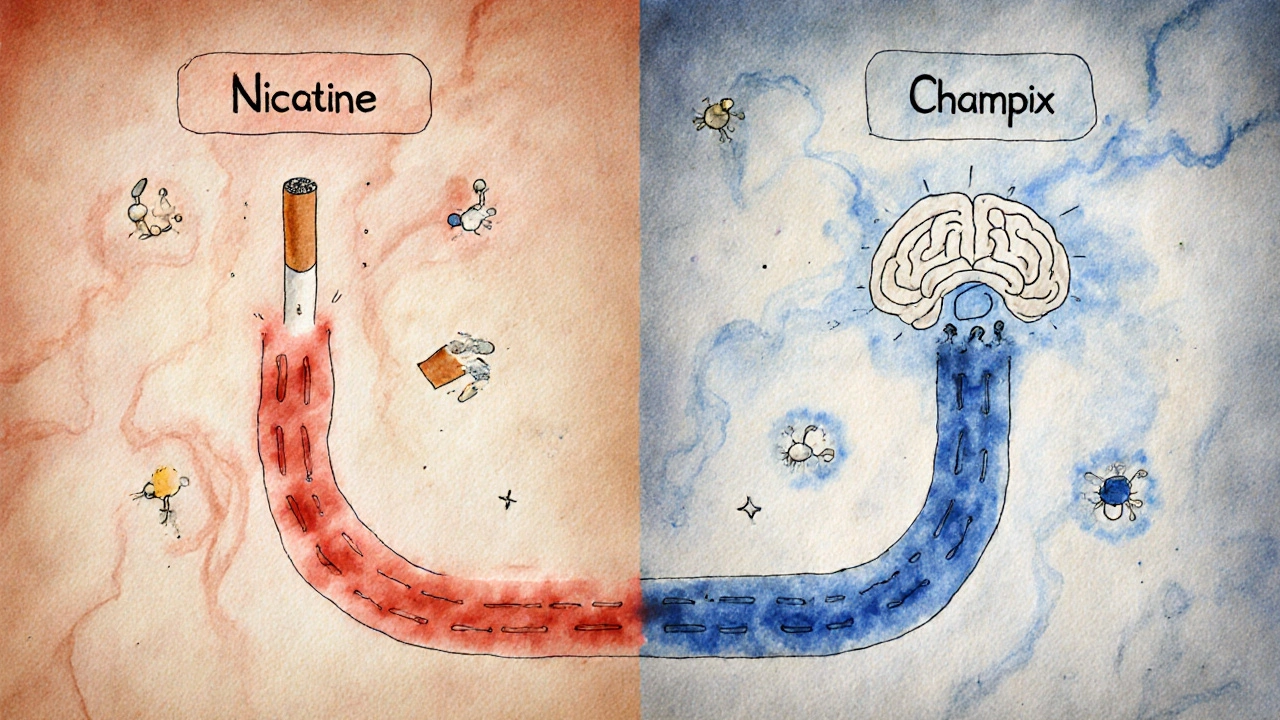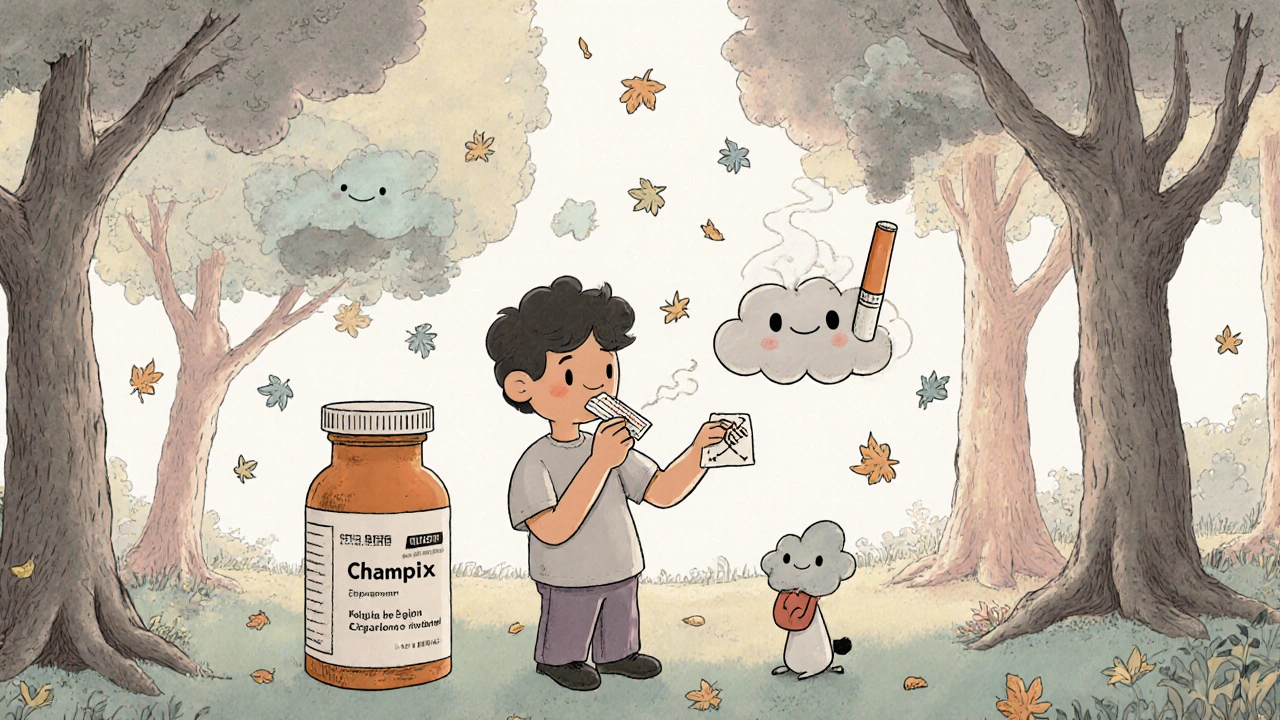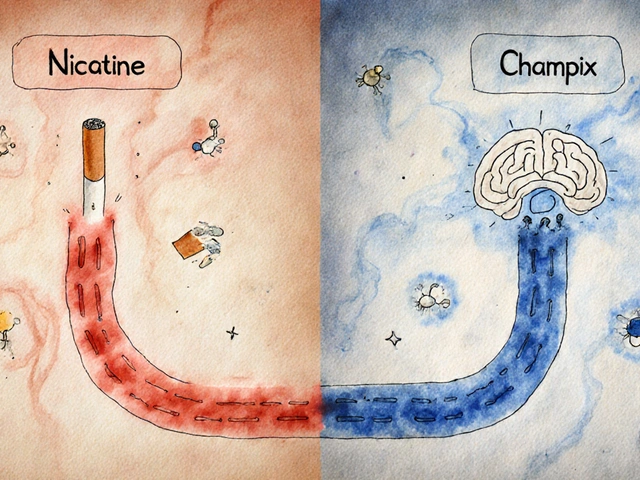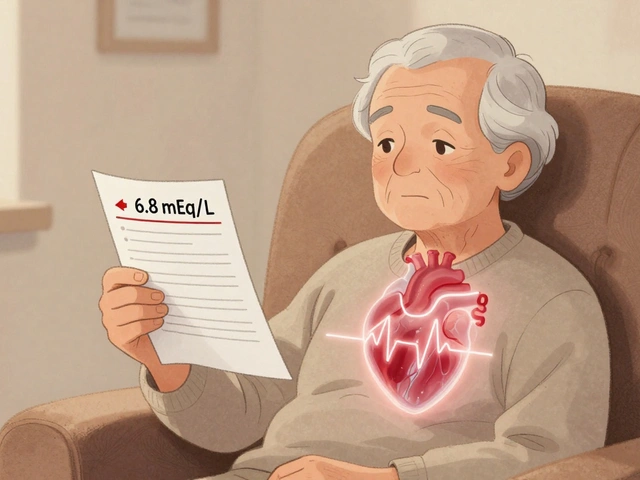30
Champix vs. Alternatives: Which Quit Smoking Treatment Works Best?

Quitting smoking isn’t just about willpower. It’s a chemical battle. Your brain has rewired itself around nicotine, and when you stop, it screams for more. That’s where medications like Champix (varenicline) come in. But is it the best option? Or are there better, safer, or cheaper alternatives? If you’re trying to quit smoking and feeling overwhelmed by choices, you’re not alone. Let’s cut through the noise and compare Champix with the most common alternatives-what works, what doesn’t, and who it’s really for.
What Champix (varenicline) actually does
Champix, known globally as varenicline, is a prescription medication designed to help people stop smoking. It doesn’t just reduce cravings-it messes with nicotine’s grip on your brain. Varenicline attaches to the same receptors in your brain that nicotine does, but it only turns them on partially. That means you get some of the dopamine release nicotine gives you, but not enough to feel a high. At the same time, if you smoke while taking Champix, nicotine can’t bind properly, so smoking becomes less satisfying.
Studies show that after 12 weeks of treatment, about 44% of people using Champix had quit smoking, compared to 18% on placebo. After a year, around 22% stayed quit. That’s significantly better than going cold turkey, which works for only about 5% of people.
But it’s not magic. Champix takes time to build up in your system. Most people start taking it 1-2 weeks before their quit date. Side effects include nausea (affects up to 30% of users), trouble sleeping, and vivid dreams. In rare cases, mood changes or depression have been reported, which is why doctors screen for mental health history before prescribing it.
Nicotine replacement therapy (NRT): patches, gum, lozenges
If you’re looking for something gentler, nicotine replacement therapy (NRT) is the most widely used alternative. It comes in patches, gum, lozenges, inhalers, and sprays. The idea is simple: give your body a steady, low dose of nicotine without the tar, carbon monoxide, and other toxins in cigarettes.
Unlike Champix, NRT doesn’t block nicotine receptors. It just replaces the nicotine your body craves. That makes it safer for people with anxiety, depression, or a history of heart disease. NRT is available over the counter in most countries, and it’s often covered by insurance.
Success rates? About 20-25% of people quit after 6 months using NRT alone. That’s lower than Champix, but combining two forms-say, a patch plus gum-can boost success to nearly 35%. NRT doesn’t cause the same brain-level changes as Champix, so cravings might still hit hard. But it’s easier to stop if you don’t like it. You can just stop using the gum or patch without tapering.
Zyban (bupropion): the antidepressant that helps you quit
Zyban is the brand name for bupropion, an antidepressant also sold as Wellbutrin for depression. It was discovered to help with smoking cessation almost by accident. Doctors noticed patients on bupropion for depression were quitting smoking without trying.
Bupropion works differently from Champix. It affects dopamine and norepinephrine in the brain, reducing withdrawal symptoms and the pleasure you get from smoking. You start taking it 1-2 weeks before quitting, just like Champix. Success rates are similar to NRT-about 20-25% at 6 months.
The big advantage? No nausea. Most people tolerate it well. But it’s not for everyone. It can cause dry mouth, insomnia, and, in rare cases, seizures-especially if you have a history of seizures, eating disorders, or are on certain other medications. It’s also not recommended for people with bipolar disorder.
Some people use Zyban and Champix together. A 2019 study in the New England Journal of Medicine found that combining them increased quit rates to 35% at 12 weeks, higher than either alone. But it’s not a first-line option due to cost and potential side effects.

What about vaping or e-cigarettes?
Many people turn to vaping as a way to quit smoking. It’s popular because it mimics the hand-to-mouth action of smoking and delivers nicotine quickly. But is it a real alternative to Champix?
It depends on your goal. If you want to quit nicotine entirely, vaping isn’t a solution-it’s a swap. But if your main goal is to stop smoking cigarettes, vaping can help. A 2021 UK study found that people using e-cigarettes to quit were about 50% more likely to succeed than those using NRT. That’s close to Champix’s success rate.
But here’s the catch: vaping isn’t regulated the same way as medications. Nicotine levels vary wildly between products. Some e-liquids contain harmful chemicals. And long-term health effects are still unknown. The FDA hasn’t approved vaping as a quit-smoking aid, and many health agencies advise against it for teens or non-smokers.
For adults who’ve tried other methods and failed, vaping can be a useful tool-but only if you have a plan to eventually quit nicotine too.
Behavioral support: the hidden key
No medication works well alone. Whether you’re on Champix, NRT, or vaping, your chances of success double if you add behavioral support. That means counseling-whether it’s through a phone line, app, or in-person session.
Smoking isn’t just physical. It’s tied to habits: after meals, with coffee, when stressed. Behavioral therapy helps you break those triggers. A 2020 review in the Cochrane Library found that people who got counseling along with medication were twice as likely to quit long-term.
Free options exist. In the U.S., the National Quitline (1-800-QUIT-NOW) offers free coaching. In the UK, the NHS Stop Smoking Service provides free support. Apps like Smoke Free and QuitGuide use daily check-ins and progress tracking to keep you on track.
Medication helps with the chemistry. Behavioral support helps with the psychology. Together, they’re the most powerful combo.
Comparison table: Champix vs. alternatives
| Method | How it works | Success rate (6 months) | Prescription needed? | Common side effects | Best for |
|---|---|---|---|---|---|
| Champix (varenicline) | Binds to nicotine receptors, reduces cravings and blocks nicotine’s effects | 22-44% | Yes | Nausea, sleep issues, vivid dreams | People with strong cravings and no mental health concerns |
| Nicotine patches/gum/lozenges | Delivers low-dose nicotine without smoke | 20-25% (up to 35% with combo) | No | Skin irritation, jaw pain, hiccups | People who want to avoid prescription meds |
| Zyban (bupropion) | Boosts dopamine to reduce withdrawal | 20-25% | Yes | Insomnia, dry mouth, rare seizures | People with depression or who can’t tolerate nausea |
| E-cigarettes | Delivers nicotine via vapor, mimics smoking behavior | 25-30% | No | Throat irritation, unknown long-term risks | Smokers who’ve failed other methods and want behavioral mimicry |
| Behavioral counseling | Identifies triggers and builds coping skills | 15-20% alone, doubles with meds | No | None | Everyone-especially those with emotional triggers |
Who should avoid Champix?
Champix isn’t for everyone. You should avoid it if you:
- Have a history of depression, suicidal thoughts, or other serious mental health conditions
- Are pregnant or breastfeeding (safety not established)
- Have severe kidney problems (dose adjustment needed)
- Are under 18 (not approved for minors)
- Have had an allergic reaction to varenicline
If you’re unsure, talk to your doctor. They can check your medical history and run a quick risk assessment. Sometimes, switching to NRT or Zyban makes more sense-even if Champix seems more effective on paper.
What if nothing works?
It’s not failure if you don’t quit on the first try. Most people need 3-5 attempts before quitting for good. If Champix didn’t work, or you couldn’t handle the side effects, try another method. Maybe combine NRT with a quit-smoking app. Or try Zyban with counseling. Or switch to vaping for a few months, then taper off.
The goal isn’t perfection. It’s progress. Even cutting down by half reduces your risk of heart attack and lung disease. Every cigarette you don’t smoke matters.
Don’t give up because one method didn’t click. Try another. Ask for help. Keep trying. Quitting smoking is hard-but it’s not impossible.
Is Champix better than nicotine patches?
Champix has higher success rates-about 22-44% at 6 months-compared to nicotine patches at 20-25%. But patches are safer, don’t require a prescription, and have fewer side effects. If you’re prone to nausea or have anxiety, patches might be the better choice. Champix works better for people with strong cravings and no mental health history.
Can I take Champix and Zyban together?
Yes, but only under medical supervision. A 2019 study found combining Champix and Zyban increased quit rates to 35% at 12 weeks. But this combo raises the risk of side effects like insomnia, anxiety, and high blood pressure. It’s usually reserved for people who’ve tried both alone and failed.
Are e-cigarettes safer than Champix?
Champix is a regulated medication with known side effects. E-cigarettes are not regulated as medicines, so their safety varies by brand and nicotine content. While vaping is less harmful than smoking, it’s not risk-free. Long-term effects are still unknown. Champix is safer for long-term use if you’re aiming to quit nicotine entirely. Vaping is better if you’re using it as a temporary replacement.
How long should I take Champix?
The standard course is 12 weeks. If you’ve quit by then, your doctor might recommend continuing for another 12 weeks to reduce relapse risk. Stopping too early increases the chance of going back to smoking. Don’t stop suddenly-talk to your doctor about tapering if needed.
Does Champix cause weight gain?
Many people gain weight after quitting smoking, regardless of the method. Champix may slightly reduce weight gain compared to quitting cold turkey, because it helps control cravings. But weight gain is still common-about 5-10 pounds on average. Eating well and staying active helps manage it.
Can I use Champix if I have heart disease?
Yes. Studies show Champix is safe for people with stable heart disease. In fact, quitting smoking is one of the best things you can do for your heart. But if you’ve had a recent heart attack or unstable angina, your doctor may recommend NRT first. Always discuss your heart health before starting any quit-smoking medication.
Next steps: what to do now
- If you’re considering Champix, schedule a doctor’s visit. Bring your smoking history and any mental health concerns.
- If you want to avoid prescriptions, start with nicotine patches or gum. Combine them with a free quit-smoking app.
- If you’ve tried everything and failed, consider vaping-but set a quit date for nicotine too.
- Call a quitline or download an app. Behavioral support is free and doubles your chances.
- Don’t wait for the perfect moment. The best time to quit is now.









Helen Moravszky
October 30, 2025 AT 07:48I tried Champix and it was a nightmare-nausea all day, dreams where I was fighting dragons made of cigarettes. But I quit! And now I don’t miss smoking at all, just miss the 3am ice cream runs I started because I was so stressed. NRT was too slow for me, but Champix? It cut the cravings like a knife. Worth it.
Reginald Matthews
October 30, 2025 AT 22:17Interesting breakdown. I used Zyban and it worked okay, but the insomnia was brutal. I’d be wide awake at 3am wondering if my toaster was judging me. NRT with gum + patch gave me the best balance-no brain fog, just a steady nicotine drip. Also, the quit app I used? Changed everything. Daily check-ins kept me honest.
Debra Callaghan
October 31, 2025 AT 21:03People act like vaping is some magic solution. It’s just nicotine with a fancy mist. You’re still addicted-you just don’t smell like an ashtray anymore. And if you’re not planning to quit nicotine entirely, you’re not quitting smoking, you’re just changing the delivery system. Champix at least breaks the cycle. Stop being lazy.
Mitch Baumann
November 2, 2025 AT 08:35Actually… I find it fascinating how the pharmacodynamics of varenicline-specifically its partial agonism at α4β2 nicotinic acetylcholine receptors-creates a neuroadaptive buffer against withdrawal… whereas NRT merely provides pharmacokinetic substitution. *sips organic matcha* And let’s not forget the behavioral conditioning component-without cognitive restructuring, even the most elegant pharmacology fails. 🤓✨
Gina Damiano
November 2, 2025 AT 10:37Wait, did anyone mention weight gain? I gained 18 lbs after quitting with Champix. My jeans are in mourning. I started walking 5 miles a day and eating more protein-still hate the extra pounds, but at least I’m alive. Also, my dog thinks I’m weird now because I don’t smoke on the porch anymore. He misses it.
Emily Duke
November 4, 2025 AT 02:40Champix made me suicidal. I’m not exaggerating. I cried for no reason, stared at walls for hours, and thought about jumping off my balcony. My therapist said it was the drug. I quit it. Switched to patches. No drama. No nightmares. Just… calm. If you have any history of depression, avoid this like the plague. Seriously.
Stacey Whitaker
November 4, 2025 AT 03:59Been smoke-free 3 years now. Tried everything. Champix? Nope. Zyban? Nope. Vaping? Felt like cheating. What actually worked? Talking to a stranger on the quitline for 20 minutes. Just someone who didn’t judge me for relapsing 4 times. That’s the real secret. Not the pills. Not the patches. Just… someone saying ‘you got this’.
Kayleigh Walton
November 5, 2025 AT 15:41Hey everyone-just wanted to say you’re all doing amazing just by being here and trying. Quitting smoking is one of the hardest things a person can do, and you’re already ahead of 90% of people who never even try. If Champix didn’t work for you, that doesn’t mean you’re weak. It just means your body needed something else. Maybe NRT + counseling? Maybe vaping as a bridge? Keep going. One day at a time. You’re not alone.
Stephen Tolero
November 7, 2025 AT 08:36Success rates cited are based on intention-to-treat analysis. Per-protocol rates are significantly higher. Also, behavioral support efficacy is underreported in many studies due to inconsistent delivery models. Recommend cross-referencing Cochrane reviews with real-world implementation data.
Brooklyn Andrews
November 7, 2025 AT 20:44Champix is overrated. I used nicotine gum and a damn good podcast playlist. Stopped after 3 weeks. No side effects. No drama. Just didn’t want cigarettes anymore. Sometimes the answer isn’t medicine-it’s just… changing your routine. Also, I started running. Now I’m addicted to sweat. Better than nicotine.